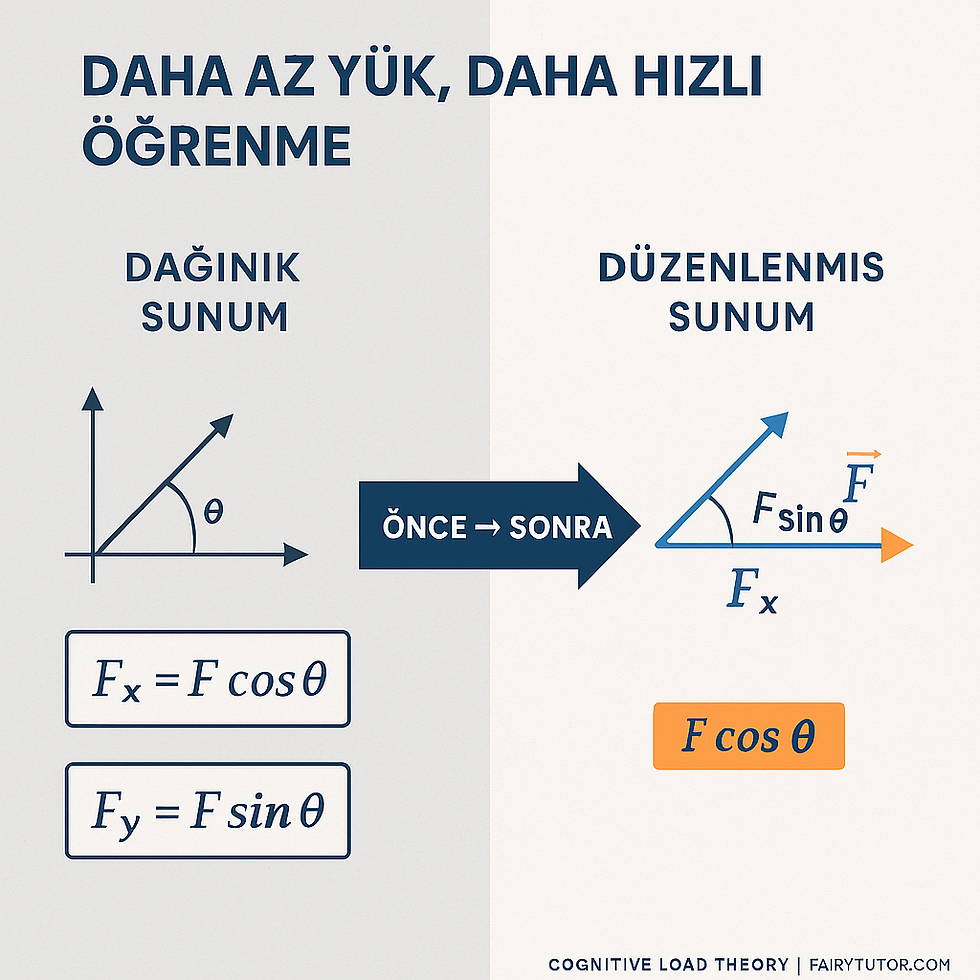Cognitive Load Theory: Study Less, Learn Faster 🚀
- Onur Acar
- Aug 13
- 4 min read
While studying for an exam, you know that moment when you say, “I get it… and then my brain fogs up”? That’s where Cognitive Load Theory steps onto the stage. CLT takes seriously the capacity of working memory—the bouncer at your brain’s front door while you study. The mind can process only a limited number of elements at once. So the goal isn’t to study more, but to study better: with well-designed materials, in the right sequence, at the right intensity. The good news: weave this framework into your routine with a few small tweaks and your learning speed visibly increases. 🚀

Cognitive load has three sources: intrinsic load from the nature of the topic, extraneous load from presentation/material flaws, and germane load—the productive effort you invest in building schemas. The short version: prune extraneous load, digest intrinsic load step by step, and feed germane load with intent. In the TYT–AYT world, that means warming up definitions and symbols in advance, integrating text and visuals in the same frame, justifying solution steps with a quick “why,” and practicing principles across varied contexts with increasingly diverse examples.
Extraneous load is where most students lose the most—without noticing. Pages where the text sits in one place and the diagram elsewhere; lectures that read slides verbatim; copy-pasted repetitions of the same information… Your eyes ping-pong, your mental energy drains. The fix is surprisingly simple: place text beside the visual, mark key points with arrows and labels, and remove redundancy. Also balance your channels: when a visual is on screen, a short, targeted spoken explanation often distributes load and speeds understanding.
Intrinsic load is the subject’s natural difficulty—and it spikes when you try to do “everything at once.” A bit of pretraining works wonders: settle terms, symbols, units, and core processes with a brief warm-up. Then segment the content; secure sub-skills first, then combine steps. Vector components, trig ratios, and coordinate transforms look hard when crammed onto a single page—but once each is internalized through a few well-chosen micro-examples, the flow suddenly clears.
Germane load is that sweet strain devoted to building schemas. To grow it, present clean solutions labeled with sub-goals that reveal the logic behind worked examples. The first example can be fully worked; in a similar follow-up problem, deliberately leave some steps blank and have the learner complete them. Support is then gradually withdrawn and independent problem-solving rises naturally. Jotting a tiny note—“Why did I take this step?”—in every solution turns abstract rules into concrete schemas.
Design’s power doesn’t end there. Add active recall and spaced repetition to create a learning flywheel. A short closed-notes mini-quiz at the end of a session, a quick mental retrieval before checking the solution, and fast reviews spaced over the next few days push the forgetting curve downward. Solving the same principle in different contexts strengthens transfer; in the exam it nurtures a choose-the-principle reflex rather than a guess-the-question-type habit.
A unit stops being a pile of memorized bullets and becomes a solid mental map.
In class or self-study, small adjustments deliver big returns. Move text next to the figure, highlight critical spots with color, add short “why” notes to steps—your prep time barely increases, yet comprehension quality jumps. As the learner advances, the worked examples that were powerful at first can bloat the load; at that stage fade the support and increase problem variety and challenge. As expertise grows, refine guidance—that’s the key to speed.
Think about the work–energy theorem in physics. If the equation is on one page, the graph on another, and the formulas on a third, your mind keeps stitching connections and gets tired. Place the equation right next to the FFF–xxx graph and shade the area, sequence steps with small labels, use a fully worked first example and a partial second, and both the eyes and the mind relax. Result: fewer errors, higher speed, and more durable learning. 🎯
This approach helps resolve the “more topics in less time” paradox of dense exams like TYT–AYT. Start with pretraining cards; use a two-column note format to separate the what and the why; run a quick active-recall round at session’s end; and reinforce with a short review a few days later. Micro-tweaks—text-visual integration, signaling, trimming redundancy, and gradually withdrawing support—lift the success curve in visible ways.
The best part: these principles work not only in math and science but also in language learning and history. The real issue isn’t the content itself, but how it’s presented to the mind and how the mind processes it. When the science of learning finds a place in your daily routine, motivation, speed, and retention form a self-reinforcing loop. Today, open a page you’re studying, merge the text with the visual, mark the crucial steps, and add a tiny closed-notes check. Tomorrow, try the same principle in a different context. By week’s end you’ll notice you’re learning more with less fatigue. 🌿
If you want to apply this approach systematically in your lessons, that’s exactly how I teach in one-to-one or online sessions. We restructure content to match the student’s level, trim extraneous load, and deliberately increase germane load. If your goal is to gain momentum on TYT–AYT, we can co-design a science-backed plan tailored to you. For a free trial lesson, book at fairytutor.com/online-randevu a design that matches your brain’s pace and see the difference for yourself.

Comments